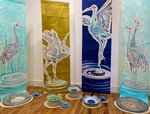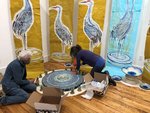



Zoe Wolfe and Carlene Roters have been colleagues and friends since 1999 when both were teaching at Western New Mexico University in the Expressive Arts Department.
“For years we have been talking of doing a collaborative installation,” Roters said. “In January 2020 we decided to create an installation, which we would do as a gift of an experience to the visitors of the Silver City Art Association Studio Tour. Little did we know at the time, we were heading into a pandemic, and there would be no SSAA Studio Tour that year.”
In January of 2020, Roters spent a few days hiking in the Chiricahua Mountains with her husband.
“Each evening we would see the Sandhill Cranes returning to roost at the Wilcox Wildlife Playa,” she said. “I was taken with the sight and the sounds.”
That experience morphed into a collaboration as the friends visited about the experience and the environment. Wolfe was taken with thoughts of precious water, and the challenge of expressing water and movement through ceramics and glazes.
“Together we meditated on our visions in our individual studios and collaborated to bring you an experience of what we think is an amazing phenomenon about living in our area,” Roters said.
Roters said batik is an Indonesian art form she learned in 1970, when she was working with junior high school students.
“It is a wax resist process where you paint in dyes and use wax as a resist to save areas and colors you do not want the next layer of dye to change,” she said. “With batik you need to think and work from light to dark and you need to understand what colors/dyes do when they blend with a new color/dye.”
Roters had had the students practice on a commercial dye paper because it was very similar to rice paper, but it was cheaper and not handmade. After they learned the batik techniques using the paper, they went on to do their final projects on cloth, as is traditionally done.
“I got to love the practice batiks on paper because the wax rendered the paper translucent when lifted to the light,” Roters said. “It reminded me of stained-glass windows. I thought that batik on rice paper could be very effective for my part in this installation.”
Rice paper is quite tough and very adaptable to the batik process, she said. But working on scrolls of 8-9 feet made it challenging to get perspective when she needed to work flat and close to a source of hot wax. she said. And she had to revamp her whole studio and hang wires across the ceiling to hang the scrolls on. Then it was a process of hanging the scrolls up, evaluating what needed to be done, taking the scrolls down, and batiking some more.
“Being a painter who usually uses oil, batik on paper posed forgotten challenges,” Roters said. “You cannot go back as in oil and change things. Once the wax is on the paper, it is there for good. So, you make your mistakes into something, you live with it, or you start again.”
Working collaboratively with Wolfe proved a challenge too. Both had a general vision to work toward but they had to work in their own respective studios due to the pandemic.
“In the end we needed to make our creations work together,” she said. “Zoe’s stunning yet whimsical ceramic pieces give a magical feeling of place with ripples and pools of water. I needed to think about how I could make them work with my batiks, yet not have them disappear in pattern and detail. I found myself looking to Chinese Screen Paintings and Japanese Nature Paintings on rice paper to simplify.”
“We had a lot of fun with it,” Wolfe said. “She and I would go to each other’s studios, masked – going back and forth to make sure it would be a cohesive vision.”
Wolfe said she likes the way the ephemeral cranes float and how her work with depicting water still has the translucently because of the materials she worked into the clay.
“I always feel while making art that we have an idea and when you start working, more ideas come and when you add another person it’s really rich,” Wolfe said. “We are two strong artists coming together and I felt the work would speak together and make a statement.”
Wolfe models with mid-fired clay bodies and uses specialty glazes, glass, and lusters to bring iridescence to the surface. Each piece is constructed to be displayed on the ground, a pedestal, as well as vertically on a wall.
“If I was a sandhill crane I would look for the shimmer to draw me to land from the sky,” she said. “Thus, when pondering the work I would bring to this collaboration, depictions of tranquil bodies of water was the obvious choice.”
There is a bench near the exhibit as it is displayed at the Light Art Space gallery and Wolfe hopes people will be able to sit and relax there. She sees it as a meditation opportunity which could bring forth respect for these ancient birds and the preciousness of water.